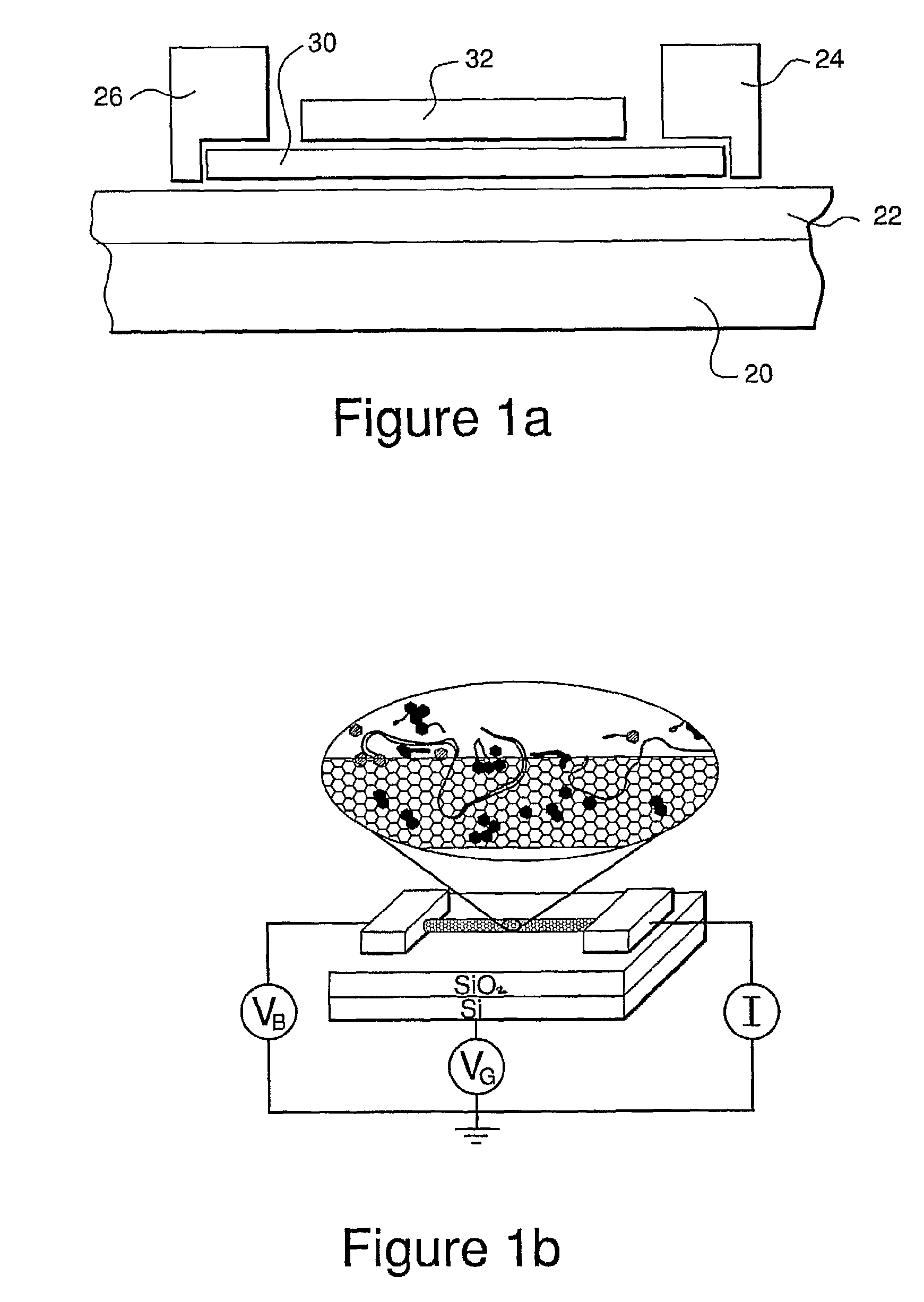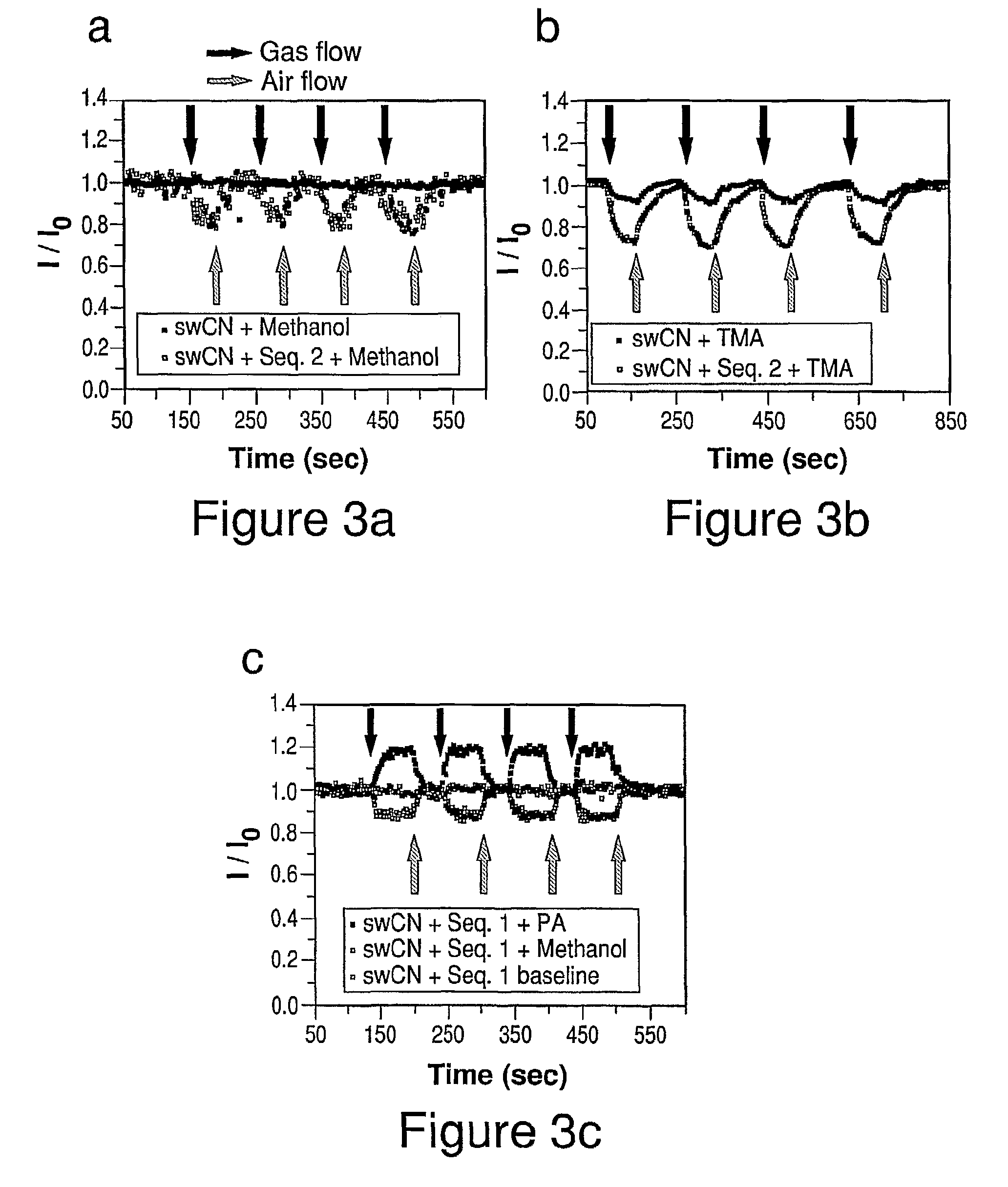Single walled carbon nanotubes functionally adsorbed to biopolymers for use as chemical sensors
a carbon nanotube and biopolymer technology, applied in the field of chemical sensors, can solve the problems of large time spent in preparing samples for analysis, poisonous ammonia, and large amount of time spent in detection and detection of leakages, and achieve the effect of compact and effectiv
- Summary
- Abstract
- Description
- Claims
- Application Information
AI Technical Summary
Benefits of technology
Problems solved by technology
Method used
Image
Examples
example 1
Preparation of SWNT-FETs
[0037]SWNTs were grown by catalytic chemical vapor deposition (CVD) on a SiO2 / Si substrate. FET circuits were fabricated with Cr / Au source and drain electrodes patterned using electron beam lithography and the degenerately doped silicon substrate used as a backgate (FIGS. 1a and b) (Radosavljevic M et al. (2002) Nano Lett. 2:761-4). For each device, source-drain current I was measured as a function of bias voltage VB and gate voltage VG under ambient laboratory conditions. Circuits consisting of individual p-type semiconducting nanotubes, where the carriers are positively charged holes, were selected by using only devices that showed a strong decrease in I(VG) for positive VG (ON / OFF ratio exceeding 1000).
[0038]ssDNA was adsorbed to the SWNT. The ssDNA functionally adsorbed to the SWNT had either of the following sequences, as described in U.S. Patent Application Publication No. 2004 / 0101851:
[0039]
5′ GAGTCTGTGGAGGAGGTAGTC 3′,(SEQ ID NO: 1)or,5′ CTTCTGTCTTGATG...
example 2
ssDNA-SWNT-FET Detection of Propionic Acid, Trimethylamiene, Methanol Dinitrotoluene, and Dimethyl Methylphosphonate
[0042]The data below demonstrate that single walled carbon nanotubes coated with single-stranded DNA oligomers show conductance changes when target molecular species are applied to a chemical sensor described herein. The odor responses are different in sign and / or magnitude for different odors and the odor responses also depend on the base sequence of the DNA decorating the SWNTs. SWNTs were fabricated and arrayed for conductance measurements in an FET-like configuration.
[0043]Five odors were used with ssDNA-decorated sensor devices of the present invention to yield differential odor responses. These odors are:
[0044]
[0045]Dinitrotoluene (DNT) is of interest because of its similarity to the explosive TNT, although DNT is not explosive. Similarly, dimethyl methylphosphonate (DMMP) is a non-lethal analogue of the nerve agent sarin.
[0046]A reservoir of saturated vapor of e...
example 3
Computer Simulations Showing the Possible Mechanism Behind Volatile Sensing Using ssDNA-Functionalized SWNTs
[0054]All-atom molecular dynamics (MD) simulations including up to 50,000 water molecules were conducted to investigate adsorption of ssDNA onto SWNTs, and the results compared with observations from experiments utilizing two different ssDNA sequences (SEQ ID NOS: 1 and 2).
[0055]Computations were carried out on Tungsten, an Intel Xeon 3.0 GHz Dell Cluster, at the National Center for Supercomputing Applications. These have recently been shifted to a local 128-node cluster. The GROMACS9 software package is employed for the MD. Electrostatic interactions were calculated using the Particle Mesh Ewald10 method. Constant temperature and pressure conditions were imposed using the Berendson thermostat, and Parrinello-Rahman barostat, respectively. (Berendsen H J et al. (1984) J. Chem. Phys. 81:3684-90; and, Parrinello M et al. (1981) J. Appl. Phys. 52:7182-90.) The AMBER99 force field...
PUM
| Property | Measurement | Unit |
|---|---|---|
| diameter | aaaaa | aaaaa |
| diameter | aaaaa | aaaaa |
| diameter | aaaaa | aaaaa |
Abstract
Description
Claims
Application Information
 Login to View More
Login to View More - R&D
- Intellectual Property
- Life Sciences
- Materials
- Tech Scout
- Unparalleled Data Quality
- Higher Quality Content
- 60% Fewer Hallucinations
Browse by: Latest US Patents, China's latest patents, Technical Efficacy Thesaurus, Application Domain, Technology Topic, Popular Technical Reports.
© 2025 PatSnap. All rights reserved.Legal|Privacy policy|Modern Slavery Act Transparency Statement|Sitemap|About US| Contact US: help@patsnap.com



